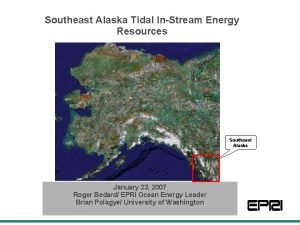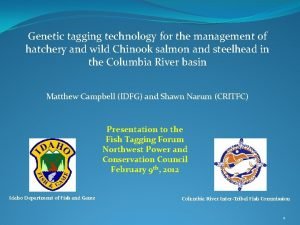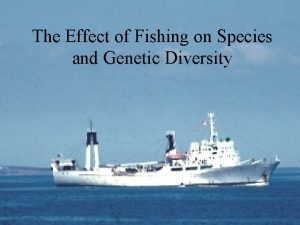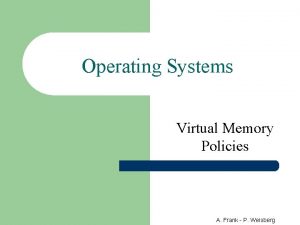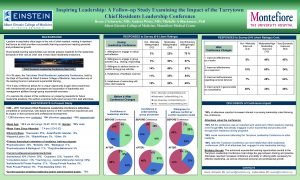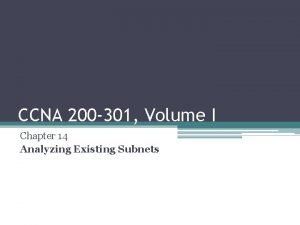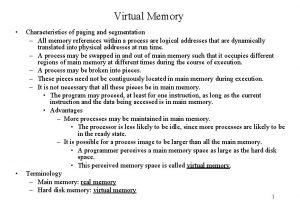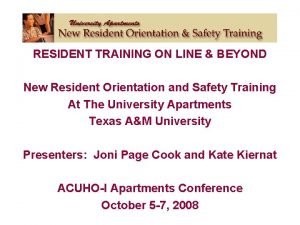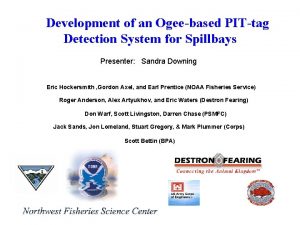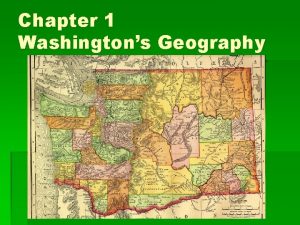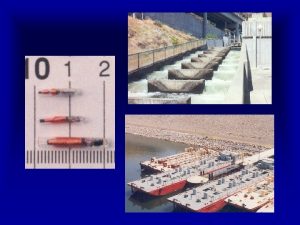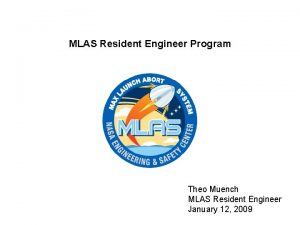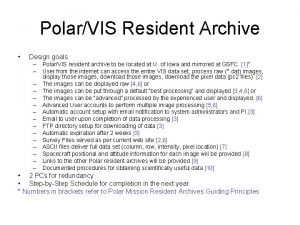InStream PITTag Detection of Resident Salmonids in Washingtons


































- Slides: 34

In-Stream PIT-Tag Detection of Resident Salmonids in Washington's White Salmon River Watershed: One System’s Saga. Ian G. Jezorek 1, Patrick J. Connolly 1, and Earl F. Prentice 2 1 Western 2 National Fisheries Research Center, Columbia River Research Laboratory, Cook, WA Marine Fisheries Service, Manchester Research Center, Manchester, WA U. S. Department of the Interior U. S. Geological Survey

Detector Site White Salmon R. Condit Dam Rattlesnake Cr. * Ind ian Cr .


Assess Current and Potential Salmonid Production in Rattlesnake Creek Associated with Restoration Efforts Funded by: Bonneville Power Administration WDFW

Habitat use and life history characteristics of rainbow trout in the White Salmon River above Condit Dam Funded by: White Salmon River (WA) Objective Assess connectivity of Northwestern Lake with mainstem White Salmon River and its tributaries

White Salmon watershed _____ How do fish use the system? Life history patterns? Tributaries Mainstem Which fish move? Environmental cues? Northwestern Lake

During August 2001, we installed two in-stream antennas and two transceivers. Upstream: Pass-thru Downstream: Pass-by

Two Transceivers One per Antenna Destron-Fearing 1001 -A, 24 V DC




December 14, 2001 High Water Challenge Bye, pass-thru!


Pass-thru blew out on 14 December 2001. - because of high water we could not redeploy until 11 March 2002. Pass-thru cable was pulled out 12 May 2002. - reconnected the cable on 28 May 2002. Three and a half months of down time for the pass-thru antenna! - the down time potentially negates any benefit from scanning more of the water column. What to do?

On 10 June 2002, we deployed a pivoting antenna. Now we are ready for high water?

31 January 2003, Uh oh!

Pivoting pass-thru antenna is down until 1 April 2003. Both pass-thru antenna designs have blown out and resulted in large amounts of down time. What to do? How about? Deploy more antennas…more, more!!

On 15 May 2003, we installed a multiplexing system with four antennas. 1 Transceiver for 4 Antennas ! Destron-Fearing Multiplexer 24 V DC

Upstream (pivoting) Downstream (tied down)


On 4 November 2003, we added two new antennas for a total of six. Two pivoting-pass-thru and four pass-by. Should the pass-thru antennas blow out we still have four pass-by antennas in the water. When we connected the fifth and sixth antennas, our read ranges crashed. Why? ?


Ra ttl es na ke Cr . PIT-Tagging Sections White Salmon River * Ind ian Cr.

Number of PIT tags deployed by section by year and number of detections at in-stream site through 1 December 2003. ____________________ Section ______________________ Year L. Ratt. Ind. Cr. U. Ratt. L. White Sal. U. White S. ___________________________ 2001 190 30 351 15 49 2002 170 73 528 92 34 2003 238 96 1, 071 96 0 2004 Total 598 199 1, 950 203 83 2005 Detections 47 5 3 20 0 2006___________________________

Detections through time

k White Salmon River ak n s e e e Cre ttl Ra Ind ian Cre ek Fish D 1 F 3 – tagged in the White Salmon R. on 12 September 2001 about 200 m below the mouth of Rattlesnake Creek (fork length = 204 mm). Interrogated in Rattlesnake Creek from 9 April – 15 May 2002. Recaptured on 15 August 2002, in the White Salmon R. about 200 m below the mouth of Rattlesnake C. (fork length 221 mm).

k White Salmon River ak n s e e e Cre ttl Ra Ind ian Cre ek Fish 0 ADE – tagged in lower Rattlesnake Creek on 15 October 2002 (fork length 95 mm). Interrogated going downstream on 23 May 2003. Recaptured in the White Salmon R. on 28 October 2003, off the mouth of Rattlesnake Creek (fork length 195 mm).

k White Salmon River ak n s e e e Cre ttl Ra Ind ian Cre ek Fish 22 CA tagged in Indian Creek on 2 November 2001 (fork length 102 mm). Interrogated going downstream on 27 May 2002. Interrogated going upstream on 11 December 2002. Interrogated going downstream on 9 May 2003.

Detection Efficiency, Two Antenna System Fish Going Downstream ______________ Antenna High flow Low flow (n=15) (n=31) ______________ 1 st 60% 80% 2 nd 23% 76% Both 69% 95% ______________

Detection Efficiency, Two Antenna System Fish Going Upstream ______________ Antenna High flow Low flow (n=4) (n=7) ______________ 1 st 100% 2 nd 50% 71% Both 100% ______________

Our Findings Detection efficiency appears acceptable, but true accuracy unknown and difficult (impossible? ) to assess. As is, our detection system is efficient enough to provide adequate sample size for assessing life history patterns in a relatively cost-effective way. Factors for non-detection confounding - Each antenna is unique (construction, location, noise) - Water depth over antenna - Channel shape: passage routes change - Ambient noise changes

Confirmed use of Rattlesnake Creek by resident trout from the White Salmon River, including repeat spawners. Some White Salmon trout enter Rattlesnake Creek in early winter. Is Rattlesnake Creek preferred overwinter habitat or is there winter spawning? Trout from Rattlesnake and Indian creeks leave Rattlesnake Creek and enter the White Salmon River. How large is Rattlesnake Creek’s contribution to the trout population in the White Salmon River? Do trout that leave Rattlesnake Creek come back to spawn there?


The USGS Crew Brady Allen Brian Beardsley Jodi Charrier Joe Feldhaus Kyle Martens Brien Rose Sarah Rose Chris Schafer
 Instream energy
Instream energy Salmonids
Salmonids Salmonids
Salmonids Washington state biomes
Washington state biomes What is george washingtons phobia
What is george washingtons phobia Lesson 2 early challenges
Lesson 2 early challenges George washingtons domestic policy
George washingtons domestic policy George washingtons terms
George washingtons terms George washingtons presidency
George washingtons presidency George washingtons presidency
George washingtons presidency George washingtons phobias
George washingtons phobias What were washingtons precedents
What were washingtons precedents Resident and family engagement
Resident and family engagement Acgme resident survey
Acgme resident survey Resident lifecycle
Resident lifecycle Placement policy in os
Placement policy in os Define resident flora
Define resident flora Tarrytown chief resident conference
Tarrytown chief resident conference Chapter 19 confusion dementia and alzheimer's disease
Chapter 19 confusion dementia and alzheimer's disease Yelena bogdan
Yelena bogdan Employment of non-resident aliens in the philippines
Employment of non-resident aliens in the philippines Chapter 2 foundations of resident care
Chapter 2 foundations of resident care Magic mask
Magic mask Resident alien telluride
Resident alien telluride Positioning transfers and ambulation
Positioning transfers and ambulation Taxpayer identifying number
Taxpayer identifying number Resident set management
Resident set management Acgme survey questions
Acgme survey questions Telephone 911
Telephone 911 Attending vs resident
Attending vs resident Resident and family engagement
Resident and family engagement Partially resident textures
Partially resident textures Biostats step 3
Biostats step 3 Resident retention
Resident retention Pab ankle fracture
Pab ankle fracture
